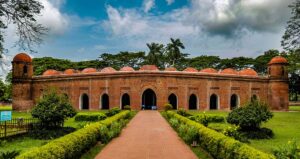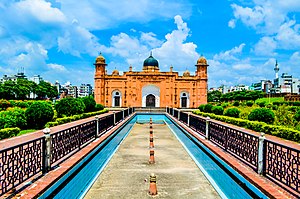Shait Gumbad Mosque

The Sixty Dome Mosque (Shaṭ Gombuj Moshjid; more commonly known as Shait Gambuj Mosque or Saith Gunbad Masjid), is a mosque in Bagerhat, Bangladesh. It is a part of the Mosque City of Bagerhat, a UNESCO World Heritage Site.
It is the largest mosque in Bangladesh from the sultanate period (1352–1576). It was built during the Bengal Sultanate by Khan Jahan Ali, the governor of the Sundarbans. It has been described as “one of the most impressive Muslim monuments in the whole of South Asia.”
As one of the important bases in the history of Islam, Bangladesh, with its many Islamic architectural structures and gardens, creates hidden beauties that are not known to everyone. The Turkish mosque with 60 domes also draws attention among touristic addresses.
A Turkish architectural work in Bangladesh, where there are more minimal works of Islamic architecture, which we are accustomed to seeing in India, is also one of the most visited points with all its magnificence and beauty. The 60-domed Bagerhat Historical Mosque will greet you like a familiar person among the crowds on your trip to Bangladesh.
It would be much more meaningful to start your tour in Bangladesh with an ancestral artifact, so we will suggest you to turn your route to Shait Gumbad Mosque first. Bagerhat Mosque stands out among the most important historical monuments of the country with its 60 domes. The 60-domed mosque, built by the Turkish General Ulu Han Cihan (Cihan Ali) in the 15th century, is known as the largest center of worship from the sultanate period. Hindu motifs are also featured on the walls of Shait Gumbad Mosque, which is a unique example of Turkish-Islamic art.
The area, where there are many mosques together with the mosques around it, is known as the “City of Mosques” and was included in the UNESCO World Heritage List in 1985.
While you have visited Shait Gumbad Mosque, you can also visit Cihan Ali Tomb and Pir Ali Tomb in its garden.
Lalbagh Fort

Lalbagh Fort (also Fort Aurangabad) is an incomplete 17th-century Mughal fort complex that stands before the Buriganga River in the southwestern part of Dhaka, Bangladesh. The construction was started in 1678 AD by Mughal Subahdar Muhammad Azam Shah, who was a son of Emperor Aurangzeb and later emperor himself. His successor, Shaista Khan, did not continue the work, though he stayed in Dhaka up to 1688.
Like Ahsan Manzil, Lalbagh Fort, lying on the banks of the Buriganga River, is a Mugall complex showing the multicultural nature of Bangladesh. Lalbagh is a brick-colored fort in Bangladesh, built in the 17th century by Subahdar Mohammed Azam Shah. The castle, which took 10 years to build, has an appearance that you can call a mini Taj Mahal in red when compared in terms of garden and architectural structure.
Lalbagh, one of the historical buildings in Bangladesh’s UNESCO World Cultural Heritage List, was started to be built during the reign of Prince Mohammed Azam Shah, but it was not completed while the Prince was alive. The son of the prince, Shaista Khan, continued the construction of the castle when he ascended the throne, but this time, he declared the castle unlucky due to his daughter’s death from illness, and the castle was abandoned again.
Further Readings
https://en.wikipedia.org/wiki/Sixty_Dome_Mosque
https://en.wikipedia.org/wiki/Lalbagh_Fort






















